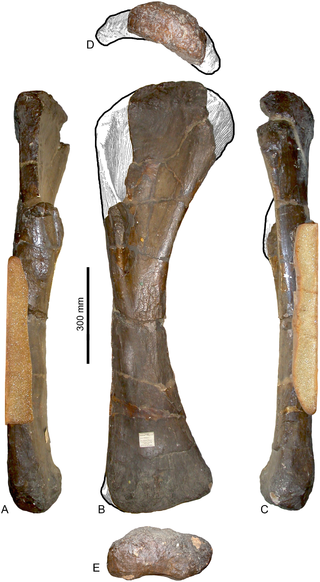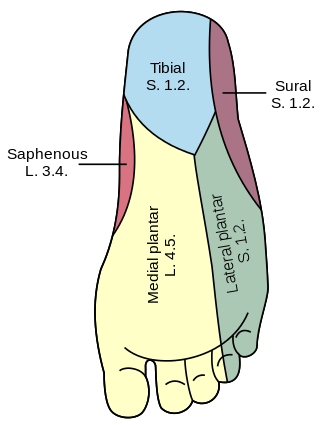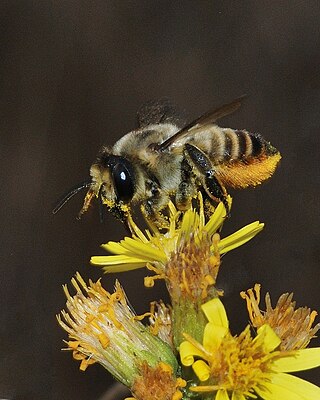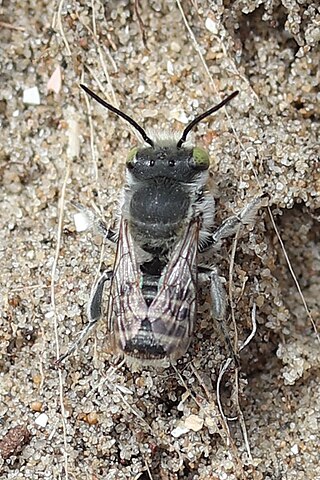
Megachilidae is a cosmopolitan family of mostly solitary bees. Characteristic traits of this family are the restriction of their pollen-carrying structure to the ventral surface of the abdomen, and their typically elongated labrum. Megachilid genera are most commonly known as mason bees and leafcutter bees, reflecting the materials from which they build their nest cells ; a few collect plant or animal hairs and fibers, and are called carder bees, while others use plant resins in nest construction and are correspondingly called resin bees. All species feed on nectar and pollen, but a few are kleptoparasites, feeding on pollen collected by other megachilid bees. Parasitic species do not possess scopae. The motion of Megachilidae in the reproductive structures of flowers is energetic and swimming-like; this agitation releases large amounts of pollen.

Pelorosaurus is a genus of titanosauriform sauropod dinosaur. Remains referred to Pelorosaurus date from the Early Cretaceous period, about 140-125 million years ago, and have been found in England and Portugal. Thomas Holtz estimated its length at 24 meters.

The flexor pollicis brevis is a muscle in the hand that flexes the thumb. It is one of three thenar muscles. It has both a superficial part and a deep part.

In human anatomy, the extensor pollicis brevis is a skeletal muscle on the dorsal side of the forearm. It lies on the medial side of, and is closely connected with, the abductor pollicis longus. The extensor pollicis brevis (EPB) belongs to the deep group of the posterior fascial compartment of the forearm.[1] It is a part of the lateral border of the anatomical snuffbox.

The extensor hallucis brevis is a muscle on the top of the foot that helps to extend the big toe.

The plantar nerves are a pair of nerves innervating the sole of the foot. They arise from the posterior branch of the tibial nerve.

Coloradisaurus is a genus of massospondylid sauropodomorph dinosaur. It lived during the Late Triassic period in what is now La Rioja Province, Argentina. It is known from two specimens collected from the Los Colorados Formation of the Ischigualasto-Villa Unión Basin.

The flexor digiti minimi brevis is a hypothenar muscle in the hand that flexes the little finger at the metacarpophalangeal joint. It lies lateral to the abductor digiti minimi when the hand is in anatomical position.

The sole is the bottom of the foot.

The genus Megachile is a cosmopolitan group of solitary bees, often called leafcutter bees or leafcutting bees; it also includes the called resin bees and mortar bees. While other genera within the family Megachilidae may chew leaves or petals into fragments to build their nests, certain species within Megachile neatly cut pieces of leaves or petals, hence their common name. This is one of the largest genera of bees, with more than 1500 species in over 50 subgenera. The alfalfa leafcutter bee is managed on a commercial scale for crop pollination, and has been introduced by humans to various regions around the world.

The Toyota Brevis is a former mid-size luxury sedan introduced in May 2001, that was sold only in Japan.

Karenia brevis is a microscopic, single-celled, photosynthetic organism in the genus Karenia. It is a marine dinoflagellate commonly found in the waters of the Gulf of Mexico. It is the organism responsible for the "Florida red tides" that affect the Gulf coasts of Florida and Texas in the U.S., and nearby coasts of Mexico. K. brevis has been known to travel great lengths around the Florida peninsula and as far north as the Carolinas.
The posterior compartment of the forearm contains twelve muscles which primarily extend the wrist and digits. It is separated from the anterior compartment by the interosseous membrane between the radius and ulna.

Karenia is a genus that consists of unicellular, photosynthetic, planktonic organisms found in marine environments. The genus currently consists of 12 described species. They are best known for their dense toxic algal blooms and red tides that cause considerable ecological and economical damage; some Karenia species cause severe animal mortality. One species, Karenia brevis, is known to cause respiratory distress and neurotoxic shellfish poisoning (NSP) in humans.

Associazione Sportiva Giana Erminio S.r.l. is an Italian football club based in Gorgonzola, Lombardy. The team currently plays in Italy's Serie C Group A.

Megachile campanulae, known as the bellflower resin bee, is a species of bee in the family Megachilidae. Described in 1903, these solitary bees are native to eastern North America. Studies in 2013 placed them among the first insect species to use synthetic materials for making nests. They are considered mason bees, which is a common descriptor of bees in several families, including Megachilidae. Within the genus Megachile, frequently also referred to as leafcutter bees, M. campanulae is a member of the subgenus Chelostomoides, which do not construct nests from cut leaves, but rather from plant resins and other materials. Females lay eggs in nests constructed with individual cell compartments for each egg. Once hatched, the eggs progress through larval stages and subsequently will overwinter as pupae. The bees are susceptible to parasitism from several other bee species, which act as brood parasites. They are medium-sized bees and the female adults are typically larger than the males. They are important pollinators of numerous native plant species throughout their range.

Megachile leachella, also known as the silvery leafcutter bee, is a species of solitary bee in the family Megachilidae. This species is widely distributed in the Western Palaearctic region from Southern Fennoscandia to North Africa and the Middle East, however the precise boundaries of the species range is not fully understood. The species was described by John Curtis in 1828.
Dewald Brevis is a South African cricketer. Brevis is also known as 'Baby AB' for his playing resemblance to AB de Villiers.















